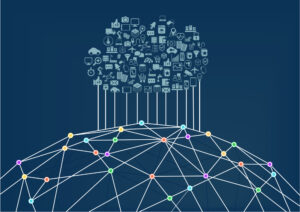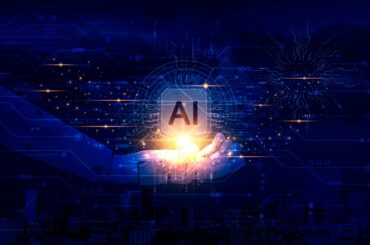
The emergence of AI-core, -infused, and -orchestrated applications needs seamless access to data from wherever it resides. Hybrid cloud offers a way to manage risk and security to ensure a smooth and successful modernization experience.
Modernizing for hybrid cloud is hard. Hybrid cloud comes with a myriad of security, application, and automation challenges, and we need a structured way to prioritize modernization efforts.
With every new generation of applications, there’s a pattern of two main things that mark a new era. One is a disruption in the market, and the other is a technology paradigm.
Each generation increases demand on the previous generation, but this new, fourth generation of applications also sets itself up nicely to tackle hybrid cloud by design – the best way for organizations to develop, modernize, and connect their applications for the future.
For example, the first generation was mainframe COBOL, which was a very discreet service that was available for people to do transaction management. Next, the second generation came along with the introduction of the internet, and we saw the rise of service-oriented architectures like Java EE – being able to do something as simple as hosting an eCommerce website. The third generation was launched with the business disruption of Cloud and mobile computing, where cloud-native architectures consisted of microservices and APIs.
The business disruption of the current generation is obvious…AI. What’s unique about this new generation of applications is the deliberate architecture needs of AI for hybrid cloud. In order to succeed in this hybrid cloud (and multi-cloud) world, we need to understand the new technology impact and market disruption, so organizations can use these new applications to their advantage.
Disruption: The evolution and impact of AI-core, AI-infused and AI-orchestrated applications
Perhaps the mind-blowing aspect of this new AI world is how many applications will be created with the addition of AI. According to IDC, there will be 1 billion new applications by 2028. AI plays a big role in speeding up the application creation and augmentation, so let’s dive into each of the new AI-based applications.
Let’s start with AI-infused applications. The most natural way to create a hyper-personalized application is to start with an existing one. We can infuse AI into it, say an AI Agent or something that makes the consumer feel the store knows what they want before even doing it. We’re seeing this everywhere – taking an existing application and modernizing it with the original application and the API layer. These AI infusions are a secondary function or added function to a pre-existing application.
The next set of AI applications is what I would call AI-core. Built by AI middleware as a template, these templates will be plugged into existing workflows, data streams, and applications. The AI model is at the core – surrounded by an application, which is then surrounded by an API, which is surrounded by events – leveraging individual services within it.
Payment fraud is a simple example. AI models are going to need a set of services that surround them with core services such as security, databases, and languages like Java, Python, and Rust to create this next generation of AI core applications. These are going to solve a specific problem that we couldn’t solve in the past. Applications of the future are going to be built with AI at the core.
Lastly, I want to touch on AI-orchestrated applications. The majority of these applications will be composed and accelerated by low-code developers using generative AI and through greater productivity of developers. A quick way for organizations to begin on this path is to find a solution that helps developers with prebuilt skills and assistants.
AI initiatives are being set across every function to increase efficiency, deliver personalized experiences, and create differentiating capabilities through the next generation of applications, but the sprawl of existing applications and data is hindering enterprises’ abilities to deliver. However, this fourth generation of applications will help organizations modernize legendary applications in a productive way that will help drive better business outcomes.
See also: How Today’s Microservices are Building Tomorrow’s Cloud
Technology paradigm: The catalog of business services
Now that we have more knowledge about the new applications being created, we can focus on the intersecting technology problems we’re trying to solve, which is fueling the hybrid cloud.
Modern organizations have a catalog of centralized business services and applications that need to be available at all times. The current set of services are largely IT-based services, mostly acceptable by APIs. However, they are quickly transforming into business-based services built as ways to scale and expand into new areas. For businesses to scale and realize the 4th generation of applications, these services must be discoverable through automated and AI-based means.”
These business capabilities can be represented as skills, processes, or applications. Regardless of how they are represented, they will ultimately be provided through an interface and surfaced as an API, and the role of the developer will be different now.
Regardless of the application type and the skill level required to compose these applications, clients need to create a single, highly curated API catalog that represents and performs business functions and logic. After all, the business depends on these services and applications running at all times and the automation that brings it all together.
How the new framework can foster hybrid cloud/multi-cloud modernization
This new framework is built to help businesses achieve their goals first and foremost. Organizations are looking to speed up business logic and value in a way that is effective in the hybrid/multicloud world and uses both new and legendary (legacy) applications.
With increasing cloud costs and cloud outages, having the flexibility to move workloads has never been more important. This means being successful with an application foundation that enables the latest advancements in technology to improve ROI and unlock new possibilities. This is reminiscent of the resurgent growth that the mainframe saw with the first online banking applications or the explosion of mobile devices.
Think of it like a teeter-totter. As soon as organizations can get to the point of creating more value with each application, the cost of AI and business operations goes down, and the teeter-totter flips to the other side.
To quickly build new capabilities, application components need to integrate with new data, cloud services, and components and migrate to a more agile and scalable cloud infrastructure. With the emergence of AI-core, -infused, and -orchestrated applications, this new framework must adapt to changing needs seamlessly while accessing data from wherever it resides – managing risk and security to ensure a smooth and successful modernization experience for the hybrid cloud.






























